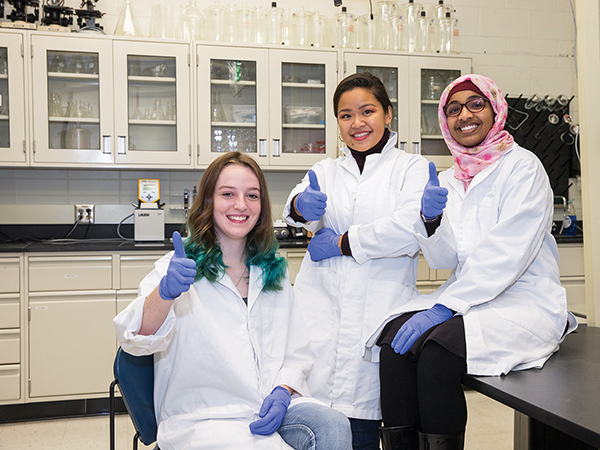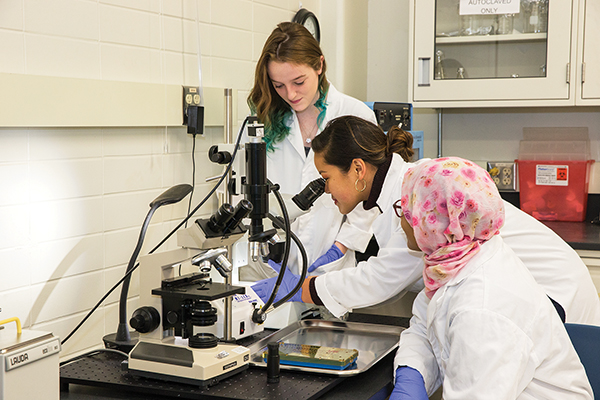Cracking Into Undergraduate Research
Story by Dorian Martin

Chickens’ eggs serve as the foundation for three innovative studies currently underway through the College of Veterinary Medicine & Biomedical Sciences’ groundbreaking initiatives, the Biomedical Research & Development Certificate and the Aggie Research Scholars Program. These programs are designed to help undergraduate students learn to do research.
Both are the brainchild of Dr. Christopher Quick, a professor in the Department of Veterinary Physiology & Pharmacology (VTPP). He started the programs in 2016, and they have grown to be the two largest undergraduate research programs at Texas A&M.
Although these two programs provided semester-long research opportunities to more than 800 undergraduates, they are not even close to meeting demand.
“Approximately one-quarter of undergraduates at Texas A&M get a chance to engage in research before graduating. The Aggie Research Program typically attracts three undergraduates for every research opportunity,” Quick said. “Last year, we could only support 50 percent of the undergraduates applying to the Biomedical Research Certificate Program. We recruit broadly, not to generate interest, but to make sure everyone has a fair shot at participating.”
“He showed up in the fall semester in one of my freshman seminar classes. You see this really eclectic professor come in shouting about this program,” said Janisah Saripada ’21, a biomedical sciences major who plans to attend medical school. “My friend and I said, ’Why don’t we try it out? It looks like a cool research opportunity.’”
Both programs, which serve students across Texas A&M University’s campus, use “research-intensive communities,” a model that involves teams of students coming together to work on research in groups instead of as individuals.
The model also encourages students to try a different research paradigm.
“Our research is more like, ‘See something, Test something and then get more questions from that test,’” Saripada said. “When you experiment and get more knowledge, your questions about the subject matter grow exponentially.”
Ultimately, this program prepares students for doing research in their careers, as well as graduate school.
“I think it’s a really good way to get hands-on experience because a lot of places want research, but it’s not being offered to undergraduates,” said animal science major Erin O’Connor ’21. “This is a good way for undergrads to get their foot in the door and get some actual real-world experience.”
Experiment 1: Radiation And Lymphatic Cells
BIMS major Oula Eldow ’21 and her team are using chicken eggs to study the effect of radiation on lymphatic vessels. The eggs, which are grown in flasks after being removed from their shells, allow students to easily witness changes.
“Being able to grow the eggs this way is very helpful because the blood vessels become really accessible,” Eldow said. “We can see how radiating these eggs will change the diameter of the lymphatic vessels. We also can see if these vessels grow differently when we radiate them versus if they weren’t radiated.”
The team believes this research will help them get a better understanding of radiation treatments used for cancer.
“When you radiate a tumor to stop its growth or kill its cells, the cells in the tumor get a very high dose of radiation, so they die or their growth is stopped,” said Eldow, who wants to become a pediatric primary care doctor with a goal of eventually working in a neonatal intensive care unit (NICU). “There is a side effect in the cells surrounding the tumor, such as lymphatic cells and blood cells. These cells get a smaller dose, so our experiment is on low-dose radiation. This low-dose radiation doesn’t kill these cells, but it does change the function. We want to see what these changes are.”

Experiment 2: Glucose And Diabetes
Saripada’s team developed their topic through meshing some initial research interests. Initially she was interested in researching how a ketogenic diet affects the body’s blood vessels. She met another student who was interested in looking at the effect of glucose in the body.
“I thought, ‘Oh, it would be a perfect idea to mesh these two projects together and look at one single disease, diabetes, because diabetes affects the levels of glucose and ketones in your body,’” the junior noted.
Using a chicken egg offers a useful way to study this problem.
“We add glucose, which is a type of sugar, and ketones, which are chemicals produced when your body doesn’t have enough insulin to convert sugar into energy,” Saripada said. “We’re basically trying to model diabetes, specifically gestational diabetes, using the Chick CAM model since it has many similarities to human embryonic development.”
Experiment 3: Sodium Fluoride And The Microvascular System
O’Connor and her team are using chicken eggs to try to detect changes in the microvascular structure through low doses of sodium fluoride.
“We chose this because we found other studies that showed that sodium fluoride affected embryo growth in frogs,” the Uvalde resident said. “We know that sodium fluoride can be in daily products, such as water and toothpaste, so we are trying to see what happens with low doses. Are they actually harmful or is it something that needs to be watched out for?”
The research may open doors for additional research on the microvascular system’s response to other teratogens.
“Teratogens are any agent or substance that affect the development of an embryo, such as malformations or birth defects,” O’Connor said. “This is important because we want to be able to identify any environmental factors that can pose a detrimental effect to a developing embryo or fetus.”
Growing Scholars And Leaders
These programs also give undergraduates the opportunities to develop skills that will serve them both inside and outside the research lab.
“The most valuable skills I’ve learned have been realizing how to work with team members and how to use everyone’s skills to really push the project in a positive direction in order to see results,” O’Connor said.
Eldow has enjoyed the opportunity to grow as both a researcher and a leader.
“This research is something that I’m very passionate about,” she said. “It’s helped me grow as a leader and grow as a student.”
###
Note: This story originally appeared in the Spring 2020 edition of CVM Today.
For more information about the Texas A&M College of Veterinary Medicine & Biomedical Sciences, please visit our website at vetmed.tamu.edu or join us on Facebook, Instagram, and Twitter.
Contact Information: Jennifer Gauntt, Director of Communications, Texas A&M College of Veterinary Medicine & Biomedical Sciences; jgauntt@cvm.tamu.edu; 979-862-4216


